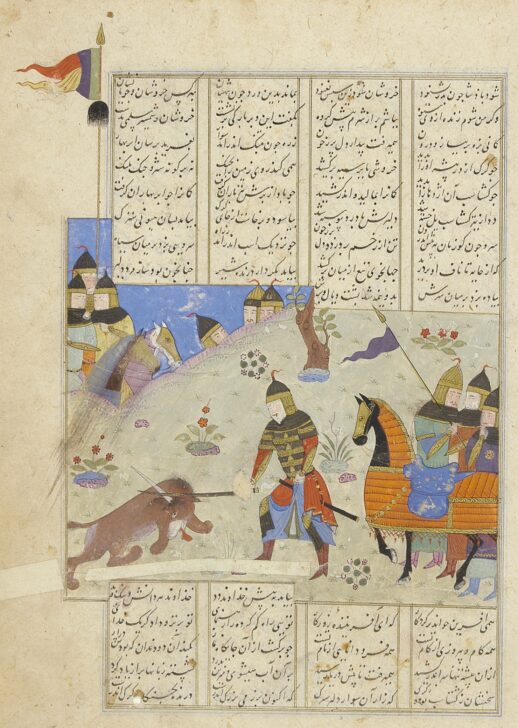Gushtasp Slays the Wolf, from the Shahnama of Firdausi
Iranian

Description
Gushtasp was Shah Luhrasp’s eldest son. Mighty in warfare but short on patience and common sense, he demanded that his father abdicate in his favor. Scolded for his insolence, he fled to Rum (lands to the west of Persia) where, after many adventures, he married one of the emperor’s daughters. The next suitor for an imperial princess was required to first dispatch a fierce wolf that was menacing the countryside. The would-be groom was a wealthy nobleman but no hunter, so he appealed to Gushtasp, who readily agreed to help.
Now when the wolf beheld him from the wood
It sent a roar up to the darksome clouds,
And like a lion or a savage leopard
Tore with its claws the ground. Gushtasp, on seeing
The monster, took in hand and drew his bow,
And showering arrows from it swift as wind
He made it as it were a cloud in spring.
When wounded by the arrows of Gushtasp
The beast became yet fiercer for the pain.
It fell, but leaping to its feet came on—
A lusty monster, butting with its horns,
Stag-like, with smarting body and in wrath,
Closed with the charger, gored its sable loins,
And ripped it up from testicles to navel.
The atheling* drew from his waist the sword,
Dismounted, smote the beast full on the head,
And clave asunder back and breast and shoulder.
Warner, IV, 337–38
This painting is unusual for this manuscript in that it departs considerably from the text. Although Firdausi emphasizes that the hunt took place in a forest with no one else present, the painter stages the episode in an open field and cannot refrain from adding witnesses. Compared to Firdausi’s fearsome “wolf,” moreover, with its tremendous size, blue fur, and two elephant-like tusks, the painter offers only a sorry cross between a large brown dog and a unicorn. This is one case where the artist took a conservative approach to his task: the wolf is almost a direct quotation from earlier versions of this same scene and the overall composition follows a well-established template.
* atheling: archaic term for the heir apparent of a royal family
———
Maribeth Graybill, Senior Curator of Asian Art
Exhibited in "A Medieval Masterpiece from Baghdad: the Ann Arbor Shahnama"
August 14 through December 19, 2004
Usage Rights:
If you are interested in using an image for a publication, please visit https://umma.umich.edu/request-image/ for more information and to fill out the online Image Rights and Reproductions Request Form.